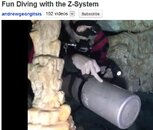The only electronics are the PPO2 monitors (Handset fails, who cares - It's typically not checked underwater anyways, so it most likely won't be noticed underwater. If the HUD fails, you go OC and make your ascent), There is an O2 and diluent addition block with QC6 connectors to jack in O2 or diluent. It lacks a switch block to jack in external stages, that is done via the diluent addition block. The stages and deco bottles also have external second stages, so that all gas is usable via OC. The added task loading comes in the form of monitoring your PPO2 (via the HUB, which can be seen by your team mates if you can see your CCR buddies mask). Since the system is completely manual, it takes practice to become proficient at, but I've seen it done successfully with some fairly task loaded dives (survey dives). It boils down to adding a component to your situational awareness. The PPO2 handsets are clipped off and other than checking them on the surface, I've never seen George look at them underwater.
I'd like your input on why you feel that having O2, turned on, and up front are major issues. Is this from a cave diving point of view of not taking a bottle deeper than it's mod? For this application (CCR), I don't treat it different than any other bottle clipped to the side. If for some reason the O2 addition block failed, all you do is turn the bottle off and/or unplug the QC6, and perhaps go on OC (SCR is an option - but usually just go OC and thumb comes out). As a team mate, I would watch my buddy and check things only when he wanted me to (Think post or stage failures). If it's fixable, it's fixable. If not, then I give the "it's ****ed" signal, we situate as needed and make our ascent. Things like dealing with an OOG diver would be handled just like an RB80 diver.
I'm not knocking the RB80 or it's success rates. I can only think of a single incident relating to the WKPP and the RB80 and their training probably saved that persons life. I would argue that the RB80 is reaching it's limits within the WKPP. - The reason that I say that is because of a dive report by Casey McKinley where he stated that they were using new canisters that were longer in length, so that they could get more scrubber material in them, so that they could get slightly longer BT durations out of them. I would agree that the UTD configuration has a couple added failure points over an RB80, but the same is also said about an RB80 comparison to OC. Based upon what I've seen (granted I'm not a RB diver), those failure points have been dramatically overblown on the various forums.






